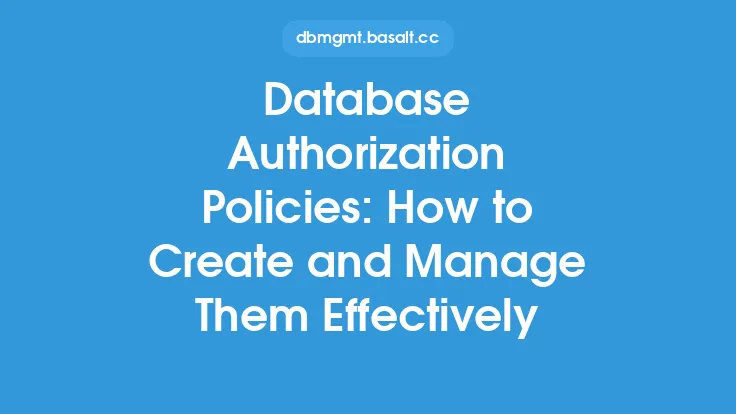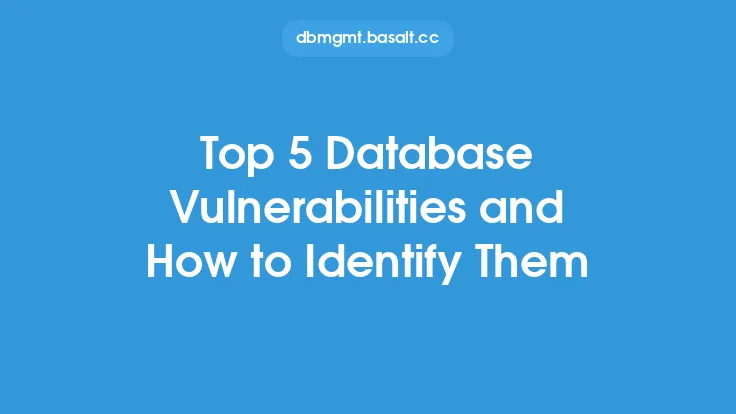Databases are the backbone of modern applications, storing sensitive information that is crucial to business operations. As such, they are a prime target for cyber attackers seeking to exploit vulnerabilities and gain unauthorized access to sensitive data. Database security risks are numerous and can have devastating consequences, including data breaches, financial loss, and reputational damage. In this article, we will explore common database security risks and how security auditing can help mitigate them.
Introduction to Database Security Risks
Database security risks can be broadly categorized into several types, including unauthorized access, data breaches, SQL injection attacks, and denial-of-service (DoS) attacks. Unauthorized access occurs when an individual or application gains access to the database without proper authorization, potentially leading to data theft or modification. Data breaches, on the other hand, involve the unauthorized disclosure of sensitive information, which can have severe consequences for individuals and organizations. SQL injection attacks involve injecting malicious code into database queries, allowing attackers to extract or modify sensitive data. DoS attacks, meanwhile, aim to overwhelm the database with traffic, rendering it unavailable to legitimate users.
Types of Database Security Risks
There are several types of database security risks that organizations should be aware of. These include:
- Insider threats: Insider threats occur when authorized personnel intentionally or unintentionally compromise database security. This can include employees, contractors, or third-party vendors with access to the database.
- External threats: External threats, on the other hand, come from outside the organization. These can include hackers, malware, and other types of cyber attacks.
- Physical threats: Physical threats involve the physical compromise of database infrastructure, such as theft or damage to servers or storage devices.
- Environmental threats: Environmental threats, meanwhile, include natural disasters, power outages, and other environmental factors that can impact database availability and security.
How Security Auditing Can Help
Security auditing is a critical component of database security, involving the systematic evaluation of database security controls and vulnerabilities. By conducting regular security audits, organizations can identify and mitigate potential security risks, ensuring the confidentiality, integrity, and availability of sensitive data. Security auditing can help in several ways, including:
- Identifying vulnerabilities: Security audits can help identify vulnerabilities in database configuration, patch levels, and access controls, allowing organizations to remediate these issues before they can be exploited.
- Evaluating security controls: Security audits can evaluate the effectiveness of existing security controls, such as firewalls, intrusion detection systems, and encryption.
- Detecting unauthorized access: Security audits can detect unauthorized access to the database, including insider threats and external attacks.
- Ensuring compliance: Security audits can ensure that database security controls are compliant with relevant regulations and standards, such as GDPR, HIPAA, and PCI-DSS.
Security Auditing Techniques
There are several security auditing techniques that organizations can use to evaluate database security. These include:
- Vulnerability scanning: Vulnerability scanning involves using automated tools to identify potential vulnerabilities in database configuration and patch levels.
- Penetration testing: Penetration testing, meanwhile, involves simulating cyber attacks on the database to identify vulnerabilities and evaluate the effectiveness of security controls.
- Configuration review: Configuration review involves evaluating database configuration settings, such as access controls, authentication, and encryption.
- Log analysis: Log analysis involves analyzing database logs to detect unauthorized access, identify potential security incidents, and evaluate the effectiveness of security controls.
Best Practices for Security Auditing
To ensure the effectiveness of security auditing, organizations should follow several best practices. These include:
- Conducting regular security audits: Regular security audits can help identify and mitigate potential security risks, ensuring the confidentiality, integrity, and availability of sensitive data.
- Using automated tools: Automated tools can help streamline the security auditing process, reducing the risk of human error and improving the effectiveness of security controls.
- Evaluating security controls: Security audits should evaluate the effectiveness of existing security controls, including firewalls, intrusion detection systems, and encryption.
- Remediating vulnerabilities: Organizations should remediate identified vulnerabilities and weaknesses, prioritizing those that pose the greatest risk to database security.
Conclusion
Database security risks are numerous and can have devastating consequences, including data breaches, financial loss, and reputational damage. Security auditing is a critical component of database security, involving the systematic evaluation of database security controls and vulnerabilities. By conducting regular security audits, organizations can identify and mitigate potential security risks, ensuring the confidentiality, integrity, and availability of sensitive data. By following best practices for security auditing and using various security auditing techniques, organizations can protect their databases from cyber threats and ensure the continuity of business operations.





